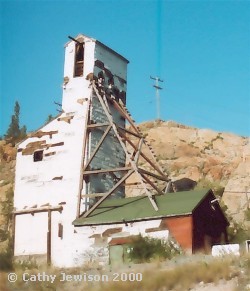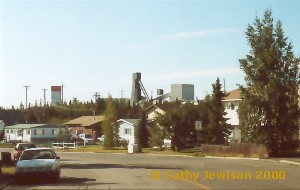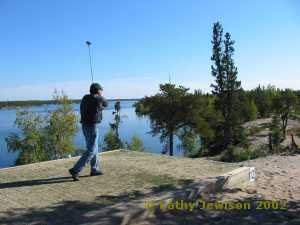|
|

|
By Cathy Jewison
Copyright © Cathy Jewison, 2007. All
rights reserved.
The local Dene (First Nations) people
call Yellowknife "S’ombak’é," which means the "money place." Others
have described Yellowknife as a city where the gold is paved with
streets. It was certainly the promise of riches that lured
Yellowknife’s early residents to the area.
In the fall of 1934,
gold was discovered on the north shore of Great Slave Lake.
By the following spring, gold fever had struck and a tent city sprung
up on Yellowknife Bay. The name "Yellowknife" was chosen in honour of
a group of local Dene who carried knives with copper blades. |

The "A" shaft headframe at Giant
Mine, on the outskirts of Yellowknife, NWT. |
| By 1938,
Yellowknife’s Con Mine poured the first gold brick in the Northwest
Territories. More mines were quickly established. Gold production was
suspended during World War II, but once the war ended, activity
quickly resumed. Con Mine reopened. Development of Giant mine began in
1945, with the first gold brick poured in 1948. Yellowknife became so
crowded that the sanitation system couldn’t keep pace, and raw sewage
ran into Great Slave Lake. A new town site was surveyed, and
construction began in 1947.
The original location of the community
is now known as the "Old Town." At the heart of the Old Town lies the
busy Yellowknife float base. Bush planes, crucial to the development
of Yellowknife and the North, are still an important means of
transporting people and goods in the wilderness.
Municipal government was
established in the late ’30s, and continued to develop over the
decades – Yellowknife became the NWT’s first city in
1970.Yellowknife’s prestige and economy were both given a boost in
1967, when it was named the capital of the NWT and the NWT
Commissioner and his staff moved north. (From 1905 until after World
War II, the Northwest Territories had been administered from Ottawa by
a commissioner and council appointed by the federal government.
Starting in 1951, elected residents of the NWT were slowly added to
the territorial council. By 1975, the Northwest Territories had a
fully elected Legislative Assembly, which represents the people it
serves.)
The gold mining industry that
founded Yellowknife started winding down in the late 1990s. Both Giant
Mine and Con Mine are now closed. |

The headframes of Con Mine
rise above a Yellowknife neighbourhood. |
| Oil and
gas exploration and diamond mining have replaced gold as the source of
much of Yellowknife’s prosperity. Diamonds were discovered on the
barren-lands north of Yellowknife in 1991. BHP Billiton’s Ekati mine,
North America’s first diamond mine, opened in 1998. The Diavik mine
began production in January, 2003. De Beers Canada’s Snap Lake mine is
scheduled to open in late 2007. Yellowknife is now home to diamond
cutting and polishing plants, as well as other secondary diamond
industries. In
addition to mining and government, Yellowknife’s economy benefits from
tourism, retail, arts and crafts, transportation and construction.
Yellowknife has grown to 19,000
residents. It’s not just the booming economy that continues to pull
people north, but also the city’s friendly and relaxed lifestyle.
Yellowknife has an active arts community. Theatrical and musical
performances are held throughout the year at the Northern Arts and
Cultural Centre, and during the summer at festivals like
Folk on
the Rocks and the
NorthWords Writers Festival. The exhibits
and archives at the
Prince of Wales Northern Heritage Centre
document the history of the NWT. Yellowknife is also home to a number
of commercial art galleries, and a
guild of crafts whose pottery sales
are eagerly anticipated by Yellowknifers.
|

Golfing at Yellowknife's
all-sand golf course. |
|
Recreational facilities include a
curling rink, swimming pool, twin-pad ice rink and an 18-hole sand golf
course. Since the city is perched on the fifth largest lake in North
America, many residents and visitors enjoy boating and fishing in the
summer.
Many people still come to the
Canadian North to seek their fortunes. Those who end up in Yellowknife
find a city rich with history and northern charm, economic potential,
and a wide range of opportunities to participate in community life. |
Copyright © Cathy Jewison, 2008. All
rights reserved. |
|

